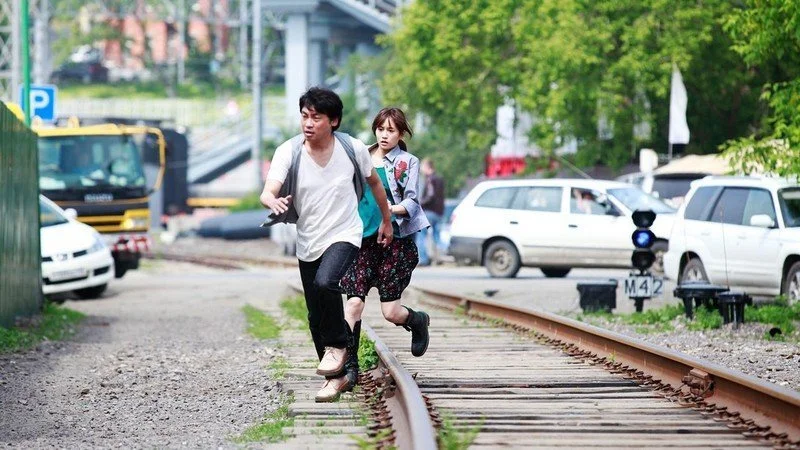From Pink Cinema to Chimes of Dread: A Retrospective on Kiyoshi Kurosawa's Short Films
Alongside many other illustrious Japanese auteurs, J-horror maestro Kiyoshi Kurosawa has made a point to be highly prolific in whatever way became available to him throughout a career stretching from the 1980s to present day, resulting in various projects ranging from Direct-to-Video features (aka "V-Cinema") to episodic television to sub-feature length short films.
Kurosawa maintained a consistent set of concerns and formal trademarks over time, using full shots of characters wandering through decaying modern/industrial spaces often invaded by nature to illustrate an atmosphere of existential isolation and a looming sense of dread even before his protagonists find themselves caught in stories rife with psychological devastation one way or another. Through his minimalist visual and narrative instincts, the director manages to consistently push out hardbitten yet also shockingly moving stories conceptualizing the most abstract of fears and anxieties through whatever genre packaging he deems worthwhile to filter his ideas through.
With this in mind, the subject of this piece will be Kurosawa's short(er) films and examining how an already restrained, highly precise filmmaker is able to conjure a comparable amount of uncanny atmosphere and insoluble storytelling into a film with a greatly reduced timespan from a feature.
KANDAGAWA PERVERT WARS
Starting off with the earliest Kiyoshi Kurosawa film that's available for viewing, 1983's Kandagawa Pervert Wars follows two sexually liberated and deeply bored young women (Usagi Asō & Makoto Yoshino) as they tire of their casual flings with boyfriends as well as each other and begin spying on an apartment building across from theirs where a young man is being held sexual prisoner by his abusive, overbearing step mother.
Full disclosure if the synopsis doesn't make it clear: if you as a viewer find copious amounts of nudity and odd (to put it diplomatically) sexual encounters onscreen to be repulsive and/or offensive, you will not like Kandagawa Pervert Wars. Born out of the pink film boom in Japan beginning in the 1970s, the film adheres to the traditions of the adult film genre by including regular instances of sex and nudity, so if that is what you're looking for, you'll find it in the most technical sense here.
However, the earliest seeds of Kurosawa's style are impossible to miss even in this unexpected package, and seeing such an early iteration of his style gives both a sense of appreciation for his later cinematic mastery and some sizable relief that a living legend was capable of starting in a widely discarded genre while still coming out with something of interest, even at an early stage of their artistic development.
Certain themes of modern isolation and psychological dysfunction leading to violence begin here and expand throughout Kurosawa's sizable body of work, but surprisingly Kandagawa Pervert Wars is likely the most wholesome Kurosawa film to date. Despite its softcore shenanigans and undeniably unsavory premise half-focused on a story of abuse and incest, the film indulges in very lightly toned ribaldry and Godardian formal maneuvers that make it clear how eager Kurosawa was to helm a project, work out his formal schema for the future (the slight shift from filming rooms from a corner showing two walls to filming rooms against one wall showing three walls would prove to be a major improvement), and throw in abundant references to filmmaking icons like the aforementioned Godard or John Ford. It's not very cerebral, but it is quite jaunty and lighthearted in contrast to the inherent taboo nature of adult filmmaking, providing some productive dissonance when darker story elements and a shocking finale complicate the tonally elastic film surrounding them.
BEAUTIFUL NEW BAY AREA PROJECT
Moving forward a few decades, we find a small miracle of compact narrative economy and visual design in Beautiful New Bay Area Project, Kiyoshi Kurosawa's contribution to a short film series commissioned in 2013 by the Hong Kong International Film Festival. In one of his increasingly frequent excursions from his homeland of Japan, Kurosawa finds a familiar setting in an industrial construction site and coldly modern headquarters serving as the backdrop for young avaricious CEO Amano (Tasuku Emoto) to develop an obsessive desire for construction worker Takako (Mao Mita), only to be rejected and resort to bizarre acts of theft and violence that attain absurd scale as the situation escalates.
Beautiful New Bay Area Project is handily the most obvious example of Kurosawa's facility with minimalist storytelling through seemingly nondescript but highly evocative and communicative visual design, making a couple of decently small locations attain a massive quality within his widescreen framing to make audiences feel the frankly ridiculous stakes of a boss unable to accept rejection from an employee inflate into existential threads on opposing needs for identity, possession, and the near mythical origin points for gendered violence.
As the story of spurned, jealous faux-love escalates to confrontation, Kurosawa shockingly displays an absolute confidence and talent for staging and choreographing protracted sequences of hand to hand combat, presumably in a gesture of appreciation for the historical propensity for jaw-dropping action filmmaking associated with the HKIFF's home country. The disquieting slow-build uncomfortability of the film's first half is paid off with desperate, thrilling fight scenes seemingly destined to precede modern digital action specialists such as Steven Soderbergh (Haywire) and David Fincher (The Killer) in their blunt brutality, technical precision, and relative elegance.
SEVENTH CODE
Still in 2013, Kurosawa directed the hour long film Seventh Code starring Atsuko Maeda as Akiko, a young woman whose outwardly naive, hapless obsession with the mysterious Matsunaga (Ryohei Suzuki) brings her in contact with shadowy Russian criminals and friendly fellow Japanese foreigners.
Seventh Code is one of the most deliberately obtuse and slowly paced Kurosawa joints despite the short running time, delivering little explanatory exposition and eventually complicating, if not contradicting most of what's been understood to be true from the start. By playing such games with the audience's perspectives and imperceptibly intensifying the "action" largely taking place just out of sight until the finale, Kurosawa makes viewers unknowingly key into the genre and genre pleasures of the film before they even fully grasp what they are, making the ever twisting story achieve a sense of a large, dense world even with the small amount of tangible narrative incident doled out over an hour.
The gritty urban and industrial environments of Russia provide a great canvas for Kurosawa to find lush images of decay, emptiness, and collapsing modernity, but most importantly they add textual depth to the story's themes of becoming unsure of one's own identity due to social isolation (particularly as a foreigner in a foreign land) and the disconnected webs of crime networks involved in untold malice, both long-standing pet obsessions of Kurosawa's.
Atsuko Maeda gives a brilliant performance in a role that's deceptively demanding, communicating Akiko's awkward haplessness when found so far out of her zone in Russia while still exhibiting an uncanny stillness and self-possession that bolsters Kurosawa's destabilizing casual oddness present in his visuals. The pair work together as well as other frequent Kiyoshi collaborators like Koji Yakusho and Show Aikawa, and it's no surprise they'd reunite for projects like Before We Vanish and the similarly themed fish-out-of-water yarn To the Ends of the Earth.
CHIME
Finally, let's take a look at a self-described "medium-length" film from 2024, Chime, the story of Takuji Matsuoka (Mutsuo Yoshioka), a chef instructor whose detached professionalism both at home and work is disrupted by the presence of a mysterious quiet chiming noise in his life.
In a certain sense, it's understandable how Chime can be taken as a simple retread or remix of Kurosawa classics like Cure or Pulse, with all of them being tales of the mundane worlds of Kurosawa protagonists afflicted by a preternaturally influential element which reveals world-shattering truths about human nature and the shaky foundations of civilized society. However, Chime is best appreciated not as a recapitulation but as a streamlined clarification of career-spanning narrative devices and thematic underpinnings.
Kurosawa's penchant for keeping the mood and tone of a given sequence unclear while an opaque atmosphere of dread hangs over it is perhaps at its most extreme here, as the world of Chime is oppressively mundane and sterile even when the usual breakdown of social order begins to reveal itself. Matsuoka wanders through situations varying in levels of violence and psychological menace with the same disquieting calm befitting most all Kurosawa protagonists, but the suffocating claustrophobia of being stuck in his perspective for the whole 45 minute runtime is unique in how little it allows the audience to grasp the full scale of what's going on until the bitter end. Instead, Chime offers some of the most precisely filmed sequences of committing and covering up crimes imaginable with plenty of alternately piercing and soothing industrial sound design in between to keep the audience afraid of an imperceptible threat. While his other shorts play with other genres, Chime proves that Kurosawa's primary talents as a director of horror shine through the most even in his most grounded, reduced-length films.
If you enjoyed this article, please consider becoming a patron of Hyperreal Film Journal for as low as $3 a month!



Matthew Collier is a writer/journalist who generally focuses on film criticism and related subjects. After graduation from the University of Texas at Austin in 2024, he currently lives in Georgetown, Texas.